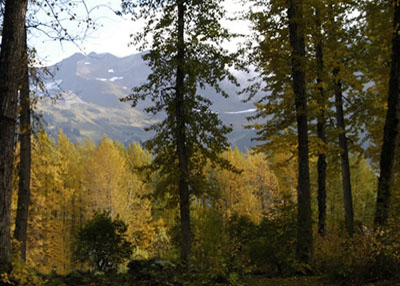Fall colors on Alaska’s national forests offer beautiful vistas

Black cottonwood and birch accentuate the fall season along Alpine Meadows
Drive in Girdwood, Alaska near the Chugach National Forest.
Photo credit: Kate Mohatt
Posted by: Mary Stensvold, U.S. Forest Service Regional Botanist, Sitka, Alaska
Ever think about fall colors in Alaska? Now’s the time with autumn foliage colors peaking from late August to early October in Alaska’s Tongass and Chugach National Forests. However, since the national forests are in the temperate part of Alaska and are dominated by coniferous trees, the colors are generally not as spectacular as the brilliant colors of interior Alaskan trees and shrubs.
Deciduous trees such as red alder (Alnus rubra), Sitka alder (Alnus viridis subsp. sinuata) and black cottonwood< (Populus trichocarpa) occur on the Tongass National Forest. Their foliage generally turns yellowish-brown to brown before being shed. Yet, the Chugach National Forest tells another story, especially on the Kenai Peninsula with the yellows and oranges of quaking aspen (Populus tremuloides), Kenai birch (Betula kenaica), and black cottonwood. The willow (Salix species) and high-bushcranberry (Viburnum edule) shrubs also turn yellow-orange and sometimes an added flash of red adorns the tips of their branches.

Caption- Black cottonwoods feature a fall wardrobe along Glacier Creek in
Girdwood, Alaska with Mount Alyeska in the background. This area is adjacent to
the Chugach National Forest. Photo by Kate Mohatt
Notable fall color changes are visible in mountain alpine plant communities and bogs, where small shrubs and herbaceous plants provide swaths and splashes of color. On the Tongass, the first alpine frosts cause the deer cabbage (Nephrophyllidium crista-galli) to turn yellow-orange on the mountain tops before they are buried in snow. On the Chugach, bright red mountain avens (Geum calthifolium) contrasts brilliantly with bright green lichens above the treeline. Many bog plants gradually change color, with leaves of the tufted bulrush (Trichophorum cespitosum) turning a golden copper and then yellowish-brown. The dwarf dogwood, sometimes called Lapland cornel, (Cornus suecica) and ripening bog cranberry (Vaccinium oxycoccus) and lingonberry (V. vitis-idaea) turn a beautiful red, and sometimes sport a range of subtle shades of red. Deer cabbage also grows in many bogs, with their leaves gradually changing to yellow.
|
![[design image slice] U.S. Department of Agriculture Forest Service on faded trees in medium light green background](/wo-resources/new/images/rmt-trees-left-usfs.gif)


